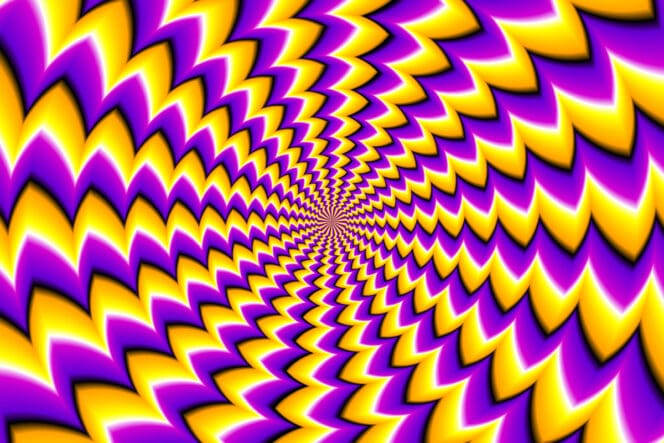When the brain receives signals from the eyes about an object or view that does not exist or that is distorted, it is called an optical illusion. The phenomenon points to an imperfection or malfunction in the vision system.

Scientists have no hard explanation for these occurrences but suggest that evolution and physiology play a key part.
A reaction to medication is one possible explanation, as is mental illness.
About Optical Illusions
Also known as visual percepts, optical illusions refer to how your brain wrongly interprets what you see. Visual percepts occur when the images you perceive are different from the objective reality.
The visual cortex of the brain is where this illusion forms. Patterns, light and colors create deceptive images, which the brain will try and fail to interpret correctly.
How Optical Illusions Work
The human vision system is complex and mostly accurate, but it can malfunction from time to time, hence optical illusions.
There is a disconnect between what the eye sees and how the brain interprets it. The brain makes the best guess based on prior knowledge and wrongly fills in some missing information to give context to the visual information and form an image.
During an optical illusion, the brain interprets the image, giving you a different perception from what is in front of you. For instance, your brain may interpret that an object is moving when that is not the information the eyes meant to convey.
When the eye perceives light to form an image, the visual cortex processes the information to give a visual experience. Sensory stimulation can be bottom-up or top-down.
- Bottom-up: Information comes from external stimuli through sight and is processed to give you a visual experience of the object. The bottom-up allows the brain to interpret what you see as it is.
- Top-down: Information from sight generates an internal visual experience from the brain because you have seen something familiar. Top-down draws from your memory to fill gaps in your vision to create an expected image.
The two complementary processes may cause illusions when their output does not tally.
Why Does Our Vision System Produce Optical Illusions?
There is no objective reason why we experience optical illusions, but scientists have suggested that evolution and physiology plan central roles.
- Evolution: In a battle for survival of the fittest, evolutionary trends dictate our brains fill in visual gaps, helping us recognize threats rapidly.
- Physiology: There is a complicated web of communication between your eyes and brain, and some information may get distorted.
Types of Optical Illusions
There are three primary types of optical illusions: literal, physiological and cognitive.
Literal Illusions
A literal illusion is when two images seamlessly look like one image. The brain will try to interpret it as one while the eyes send communication to the brain to analyze it as two.
Physiological Illusions
These are images formed due to the overuse of the brain’s senses as the brain is susceptible to movement. Physiological illusions occur when the eye perceives too much light, movement, and color, confusing the brain.
Cognitive Illusions
Of the three types of visual illusions, these are the most complex. Cognitive illusions use the subconscious part of the brain and how well the brain relates to the image. The brain is responsible for giving depth to your thoughts and whatever the eyes see.
Everyday Optical Illusions
Our brain interprets raw information from the eye to create a distinct and clear image in your mind, but this process requires filling in gaps in visual information. As the brain evolved, it developed mechanisms to fill up missing or distorted information accurately.
Even with these safeguards and fail-safes, a pattern can easily fall through the cracks and get distorted and misinterpreted, even from everyday objects. Some of the more common optical illusions from everyday objects include:
- Hidden objects
- Distorted dimensions
- Slimming stripes
Hidden Objects
An example of illusion from hidden objects is an inkblot on a plain piece of paper or random clouds on a gloomy day in the sky. The brain can interpret such random objects as complicated visual objects.
Poor lighting can also cause this effect when parts of your visual image get covered in dim lighting conditions, triggering familiarity.
Distorted Dimensions
These illusions work by converging lines to appear as parallel lines, extending them over a longer distance. It is difficult for the brain and the eye to interpret size and distance as the same thing, such as train tracks.
Slimming Stripes
In these cases, considering clothing designs, clothes with vertical stripes tend to make the body look wider, as clothes with horizontal lines make the body appear tall and slimmer. However, all these depend on one’s body shape.
Optical Illusions as Sign of Illness
Optical illusions or hallucinations can be a side effect of drugs, and sometimes, they may signify perceptive abnormalities. Seizures and migraines are also common causes of optical illusions.
To determine the cause, rule out any medication and mental health issues as triggers. You can then conduct a proper visual examination. It is essential to seek medical attention if optical illusions persist or affect your everyday vision.
References
-
Optical illusions. (November 2021). National Eye Institute.
-
How does an optical illusion work? (October 2019). The University of Queensland, Australia.
-
Neuro-ophthalmology Questions of the Week: Hallucinations and Illusions 1. (January 2018). Stanford School of Medicine.
-
Optical Illusions. (June 2012). Colorado Springs Fine Arts Center.
-
Bottom-up and top-down processing in visual perception. Columbia University.
Last Updated May 2, 2022
Note: This page should not serve as a substitute for professional medical advice from a doctor or specialist. Please review our about page for more information.